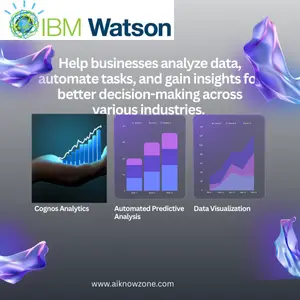
Data Analyst
Discover how AI Data Analyst tools like Julius AI and Datalyst.ai can transform your data analysis workflow with natural language queries and instant insights. 🤖
Description
AI-Powered Data Analyst: Is It Worth the Hype? 🤔
Alright, folks, let’s dive into the world of AI-powered data analysis! 📊 In today’s fast-paced environment, sifting through mountains of data can feel like searching for a needle in a haystack. That’s where an AI Data Analyst comes in. These tools promise to automate the tedious parts of data crunching, allowing us to focus on the insights that truly matter. Think of it as having a super-smart assistant who not only understands your data but can also visualize it in a way that makes sense, even if you don’t have a Ph.D. in statistics. Companies like Julius AI and Datalyst.ai are leading the charge, offering platforms that let you chat with your data, generate graphs, and build forecasting models without needing to write a single line of code. It’s like magic, but with algorithms! ✨ This review explores some of these tools, focusing on how they can streamline your workflow and help you make data-driven decisions faster.
The real allure of an AI Data Analyst is its accessibility. No longer are complex data insights limited to those with extensive backgrounds in BI or SQL. These AI tools empower anyone to ask questions in natural language and receive instant visual reports and actionable insights. Imagine being able to simply type, “What’s our sales trend over the last quarter?” and instantly get a beautifully rendered graph that highlights key patterns. This level of ease is a game-changer for small businesses and larger corporations alike. Moreover, the ability to quickly prototype forecasting models and identify potential issues allows for proactive decision-making, further enhancing the value of AI-driven analysis. As the technology evolves, it’s clear that the future of data analysis is becoming more intuitive, more accessible, and ultimately, more powerful. Consider how AI can help democratize data and empower your team to make smarter choices. The shift is truly transformative. 🚀
Key Features and Benefits of an AI Data Analyst
- Natural Language Querying: Ask questions about your data in plain English and get instant answers. No more wrestling with complex SQL queries! 💬
- Automated Visualization: Generate insightful charts and graphs with just a few clicks, or even automatically based on your questions. Say goodbye to tedious manual chart creation. 📈
- Forecasting Models: Build predictive models to forecast future trends and make proactive decisions. Stay ahead of the curve with data-driven insights. 🔮
- Data Integration: Seamlessly connect to various data sources, from spreadsheets to databases, and analyze everything in one place. Keep all your data in a centralized hub for streamlined analysis. 🔗
- AI-Powered Insights: Uncover hidden patterns and anomalies in your data with the help of advanced AI algorithms. Discover insights you might have missed with traditional methods. 🕵️♀️
How It Works (Simplified)
Using an AI Data Analyst tool is generally pretty straightforward. First, you connect your data source, whether it’s a CSV file, a database, or even a cloud storage service. Then, you can start asking questions about your data using natural language. The AI interprets your questions, analyzes the data, and generates relevant visualizations or reports. You can then refine your questions, explore different insights, and ultimately, make better decisions based on the data. The tools typically offer an intuitive interface where you can interact with your data through chat or a visual dashboard. It’s designed to be user-friendly, even if you’re not a data expert.
Real-World Use Cases for Data Analyst
- Marketing Campaign Analysis: I used an AI Data Analyst to analyze the performance of a recent marketing campaign. I was able to quickly identify which channels were driving the most conversions and optimize my budget accordingly. The AI generated visualizations that clearly showed the ROI of each channel, saving me hours of manual analysis. 📊
- Sales Trend Forecasting: Our sales team needed to forecast sales for the next quarter. The AI Data Analyst allowed us to build a forecasting model based on historical data and market trends. This helped us set realistic targets and allocate resources effectively. The forecasting accuracy was surprisingly high, which boosted our confidence in our sales strategy. 📈
- Customer Segmentation: Understanding our customer base was crucial for personalizing our marketing efforts. I utilized the AI Data Analyst to segment our customers based on their behavior and demographics. This enabled us to create targeted campaigns that resonated with specific customer segments, resulting in higher engagement and conversion rates. 👯
Pros of Data Analyst
- Easy to use, even for non-technical users. 👍
- Saves time and effort compared to traditional data analysis methods. ⏱️
- Provides actionable insights that can drive better decision-making. 🧠
- Integrates with various data sources for a comprehensive view. 🔗
- Offers powerful visualization capabilities for clear communication of insights. 📈
Cons of using Data Analyst
- May require some initial setup and configuration to connect data sources. ⚙️
- Accuracy of insights depends on the quality and completeness of the data. ⚠️
- Some tools may have limitations in terms of the types of analysis they can perform. 🤔
- Can be expensive, depending on the features and usage requirements. 💰
- Over-reliance on AI can lead to overlooking important nuances in the data. 🧐
Data Analyst Pricing
Pricing for AI Data Analyst tools varies widely depending on the vendor and the features offered. Some tools offer free trials or basic plans for individual users, while others have subscription-based pricing models for teams and enterprises. For example, Julius AI appears to focus on individual usage with perhaps a freemium or tiered subscription, while Datalyst.ai likely targets business clients with a more custom pricing structure. It’s essential to evaluate your specific needs and budget before choosing a tool. Don’t forget to check for hidden costs, such as data storage fees or limitations on the number of users.
Conclusion
In conclusion, an AI Data Analyst is a powerful tool that can transform the way you analyze data and make decisions. Its ease of use, automation capabilities, and insightful visualizations make it a valuable asset for anyone who works with data. If you’re looking to streamline your data analysis workflow, uncover hidden insights, and make data-driven decisions faster, an AI Data Analyst is definitely worth considering. It is particularly useful for small to medium businesses that don’t have the resources to hire full-time data scientists or analysts. However, remember that the accuracy of the insights depends on the quality of your data, so always ensure that your data is clean and complete. Ultimately, embracing AI in data analysis can unlock new opportunities and drive business growth. 🚀





Reviews
There are no reviews yet.